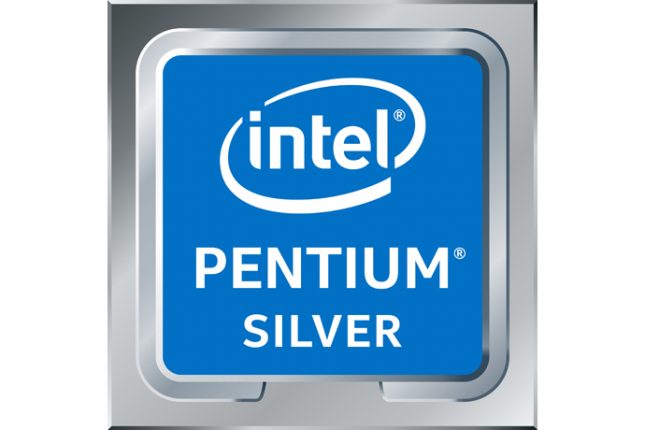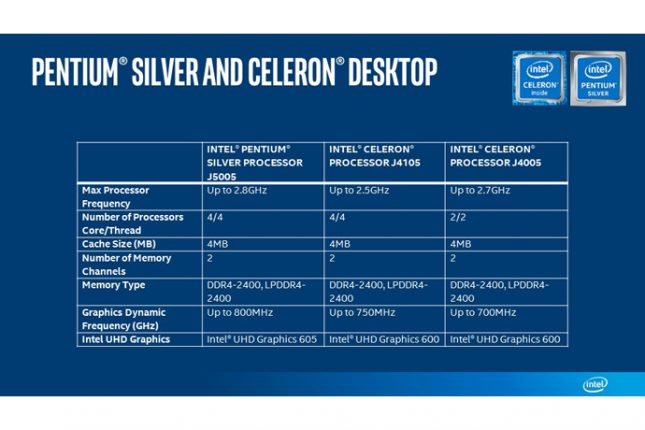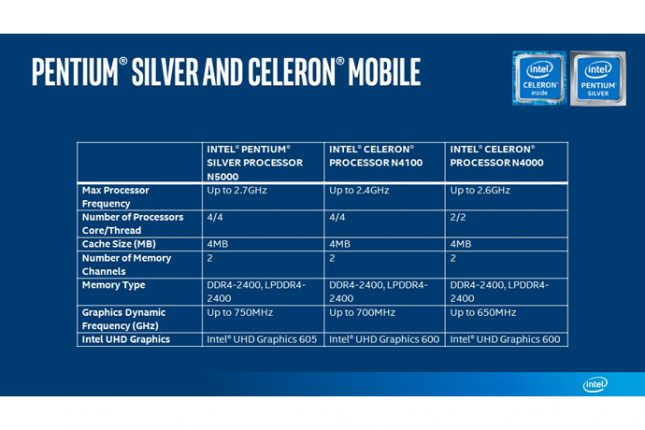Intel delivers industry-leading innovations and creates new experiences across its portfolio products. Today, Intel unveils the all-new Intel Pentium Silver and Intel Celeron processors.

The new Intel Pentium Silver and Intel Celeron processors are based on Intels architecture codenamed Gemini Lake, and are engineered for a great balance of performance and connectivity for the things people do every day working on office documents and spreadsheets, browsing online, enjoying favorite shows and movies, and editing photos with great battery life. And it can all be performed on a range of devices at an amazing value. Pentium Silver will deliver 58 percent faster1,7 productivity performance compared with a similar 4-year-old PC.
The Pentium brand also adds a new extension after offering a range of processor performance for years. To help differentiate processor performance levels and make it easier for consumers to decide which device is best for them, Intel is introducing new brand levels: Intel Pentium Silver and Intel Pentium Gold. Intel Pentium Silver processors launching today and based on the Gemini Lake architecture represent the cost-optimized option in the Intel Pentium processor family. Intel Pentium Gold processors which are already in market based on the Kaby Lake architecture represent the highest-performing Pentium processors available7.
It is clearer than ever that fast and reliable connectivity is critical. For the first time on any PC platform, Intel will offer Gigabit Wi-Fi capability for ultra-fast connectivity with all-new Intel Pentium Silver and Intel Celeron processors. Using the industry standard of 22 802.11AC with 160MHz channels, users now have the capability for extremely fast networking performance that delivers download speeds up to two times faster compared with systems using 802.11AC, 12 times faster compared with systems using 802.11 BGN, and even faster than a wired Gigabit Ethernet connection3,4,7. Ultimately, this translates to Intel Gigabit Wi-Fi providing a blazing fast connection that allows users to enjoy devices uninterrupted faster content streaming, collaborating with ease, faster web browsing and even downloading large files like HD movies in a flash.
Additionally, Intel Pentium Silver and Intel Celeron-based systems will be able to handle the latest in enhanced media for a great experience streaming content from popular sites like YouTube* and Netflix*. Understanding that people arent watching content in perfectly lit rooms, Intel is also delivering for the first time a display technology called Local Adaptive Contrast Enhancement (LACE) to the value space. This technology is designed to help people clearly see the screen outdoors in glare and bright light. All of this comes with hardware-enabled security for a faster and safer online experience that people expect from Intel products.
The new processors launching today are:
- Intel Pentium Silver processors N5000 for mobile and J5005 for desktop
- Intel Celeron processors N4100 and N4000 for mobile and J4105 and J4005 for desktop
PCs are a personal choice. With Intel Pentium Silver and Intel Celeron processors, Intel has worked hard to ensure buyers have the flexibility to choose from a range of designs laptops, 2 in 1s, all-in-one PCs, mini PCs and desktops and price points, providing a value-priced PC that handles the things they do most at home, at school or on the go. Look for designs from major OEMs to launch in the first quarter of 2018.
Intel Pentium Silver and Intel Celeron Processors By the Numbers:
- Download an 8GB HD movie before leaving on an airplane in about one minute with Intel 9560 AC as opposed to 10 minutes with 802.11 BGN3,4,7
- Up to two times faster download speed than a 22 802.11AC3,4,7
- Binge watch your favorite shows for up to 10 hrs2,7 of HD local playback without having to recharge (35WHr battery)
Intel Pentium Silver Processor vs. 4-Year-Old Entry System:
- Work on spreadsheets, browse online and edit photos up to 58 percent faster1,7
- Edit a photo album in half the time5,7
- Create a video slideshow from your favorite photo album in about half the time6,7
1As measured by SYSmark* 2014 SE on Intel Pentium Silver Processor N5000 vs. Intel Pentium Processor N3540 (58%) and Intel Pentium Silver Processor J5005 vs. Intel Pentium Processor J2900 (68%) Intel Pentium Silver Processor N5000 , PL1=6W TDP, 4C/4T, up to 2.7GHz, Memory: 2x2GB DDR4 2400, Storage: Intel SSD, OS: Windows* 10 RS2
2As Measured by Windows 10* 1080p 24fps Local Video Playback Component Average Power Disconnect all USB devices, connect to a local WiFi access point and set the screen brightness to 200 nits (disable DPST, set brightness to 200 nits on a white background and enable DPST). Wait for 10 mins for the OS to completely idle. Launch Tears of Steel (1080p H264 10MBps 24fps) video using the Windows Movie & TV App. Measure and calculate average power for the duration of the video. Report 3 run median. Configuration; Intel Pentium Silver Processor N5000 , PL1=6W TDP, 4C/4T, up to 2.7GHz, Memory: 2x2GB DDR4 2400, Storage: Intel SSD, OS: Windows* 10 RS2 Battery: 35WHr, 12.5, 19201080.
3802.11ac 22 160 MHz enables 1733 Mbps maximum theoretical data rates, 2x faster than standard 802.11ac 22 80 MHz (867 Mbps) and nearly 12x faster than baseline 11 BGN (150 Mbps) Wi-Fi as documented in IEEE 802.11 wireless standard specifications, and requires the use of similarly configured 802.11ac wireless network routers or better. To achieve Gigabit wireless speeds, the network requires a wireless router/access point that supports 160 MHz channels.
4Estimates for Wi-Fi download times are calculations based upon real-world, single client, best-case throughput speed assumptions of approximately 70% of IEEE 802.11 specification theoretical maximum data rates to account for networking overhead. Actual performance may vary based on system design, network configuration, and wireless environment.
5As measured by TouchXPRT* 2016 (Beautify Photos Subtest) on Intel Pentium Silver Processor N5000 vs. Intel Pentium Processor N3540 (58%) Intel Pentium Silver Processor N5000, PL1=6W TDP, 4C/4T, up to 2.7GHz, Memory: 2x2GB DDR4 2400, Storage: Intel SSD, OS: Windows* 10 RS2
6As measured by TouchXPRT* 2016 (Create Slideshow from Photos Subtest) on Intel Pentium Silver Processor N5000 vs. Intel Pentium Processor N3540 (58%) Intel Pentium Silver Processor N5000, PL1=6W TDP, 4C/4T, up to 2.7GHz, Memory: 2x2GB DDR4 2400, Storage: Intel SSD, OS: Windows* 10 RS2
Mobile
Intel Pentium Silver Processor N5000 , PL1=6W TDP, 4C/4T, up to 2.7GHz, Memory: 2x4GB DDR4 2400, Storage: Intel SSD 540, OS: Windows* 10 RS2 ; Battery Size: 35WHr; Display: 11.5 1910
Intel Pentium Processor N3540, PL1=7.5W TDP, 4C/4T, up to 2.66GHz, Memory: 2x4GB DDR3L-1333, Storage: Intel SSD 540, OS: Windows* 10 RS2
Desktop
Intel Pentium Silver Processor J5005, PL1=10W TDP, 4C/4T, up to 2.8GHz, Memory: 2x4GB DDR4 2400, Storage: Intel SSD 540, OS: Windows* 10 RS2
Intel Pentium Processor J2900, PL1=10W TDP, 4C/4T, up to 2.67GHz, Memory: 2x4GB DDR3L-1333, Storage: Intel SSD 540, OS: Windows* 10 RS2
7Software and workloads used in performance tests may have been optimized for performance only on Intel microprocessors. Performance tests, such as SYSmark and MobileMark, are measured using specific computer systems, components, software, operations and functions. Any change to any of those factors may cause the results to vary. You should consult other information and performance tests to assist you in fully evaluating your contemplated purchases, including the performance of that product when combined with other products. For more complete information visit http://www.intel.com/benchmarks.
Intel is a sponsor and member of the BenchmarkXPRT Development Community, and was the major developer of the XPRT family of benchmarks. Principled Technologies is the publisher of the XPRT family of benchmarks. You should consult other information and performance tests to assist you in fully evaluating your contemplated purchases.
Intel technologies features and benefits depend on system configuration and may require enabled hardware, software or service activation. Performance varies depending on system configuration. No computer system can be absolutely secure. Check with your system manufacturer or retailer or learn more at www.intel.com.
Cost reduction scenarios described are intended as examples of how a given Intel- based product, in the specified circumstances and configurations, may affect future costs and provide cost savings. Circumstances will vary. Intel does not guarantee any costs or cost reduction.


